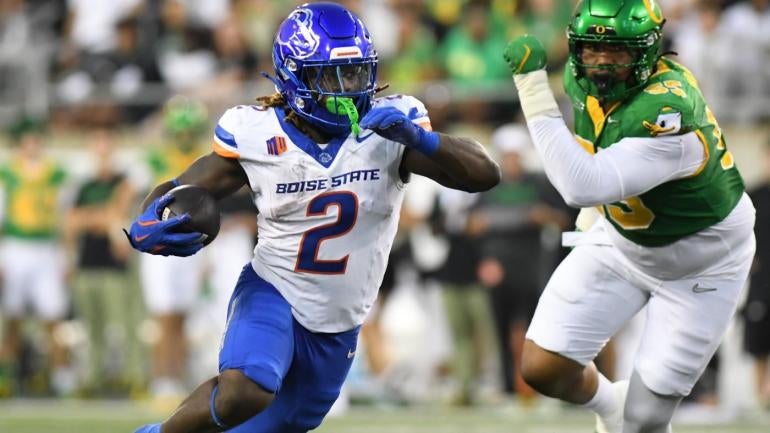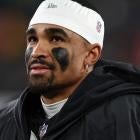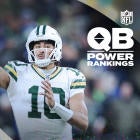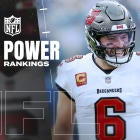
This wisdom from Marshawn Lynch perfectly encapsulates my thoughts while watching Ashton Jeanty's film at Boise State this season.
"If you just run through somebody's face, a lot of people ain't going to be able to take that over, and over, and over, and over, and over again."
Jeanty is putting on a demolition derby every week he's on the field, and part of why I believe I was taken back to that iconic quote from Lynch is because this Boise State superstar emanates Lynch-type vibes toting the rock. And while not Adrian Petersonian untouchable, comparisons to Lynch are extraordinarily rare.
Also tracking with the legendary running back theme, Jeanty is a still-not-21-year-old, former four-star recruit in the 2022 class who, six games into this season, is pacing 125 yards ahead of Barry Sanders' mythical 2,628 yards in 1988 that remains the most rushing yards in a single season in Division 1 college football.
The grandiose comparison and Jeanty's hyper productivity beg the question -- how good of an NFL prospect is he?
Time to examine.
The Numbers
Let's start with Jeanty's collegiate career to date. Below I've compared them to what feels like a nice collection of the consensus "best" running back prospects over the past five to 10 years. I included Joe Mixon because of my affinity for his on-field talent at Oklahoma. Career carries are in parentheses after each runner's name. And Breakaway Percentage is the amount of yards a ball-carrier accumulates on runs longer than 15 yards divided by total rushing yards.
| Career Missed Tackles Forced % | Yards After Contact Per Rush | Breakaway % | |
|---|---|---|---|
Ashton Jeanty (499) | 37.6% | 5.01 | 49% |
Saquon Barkley (672) | 25.4% | 3.51 | 54.9% |
Bijan Robinson (539) | 39.3% | 4.40 | 43.3% |
Christian McCaffrey (631) | 19.0% | 2.89 | 37.1% |
| Joe Mixon (301) | 26.2% | 3.75 | 52.9% |
| Breece Hall (717) | 27.3% | 3.22 | 46.3% |
With the smallest sample of the group after Mixon, Jeanty has been the second-most elusive, trailing only Robinson. He's been more effective after contact than everyone else featured here, and has accumulated yards on runs beyond 15 yards at a higher rate than everyone beyond Barkley and Mixon.
Strong showing from a career perspective from Jeanty, and his reasonably low workload is undoubtedly a plus as he looks forward toward the NFL.
Now, those same statistics from a single-season perspective. Without an all-encompassing metric for effectiveness, I used my own discretion to select the individual campaigns from each runner for this table. And what's listed are figures through the first six games of said seasons.
| Missed Tackles Forced % | Yards After Contact Per Rush | Breakaway % | |
|---|---|---|---|
2024 Ashton Jeanty (126) | 44.4% | 7.25 | 65.1% |
2015 Saquon Barkley (88) | 34.0% | 4.51 | 57.9% |
2022 Bijan Robinson (125) | 48.8% | 4.23 | 42.3% |
2015 Christian McCaffrey (130) | 19.2% | 2.73 | 35.2% |
| 2016 Joe Mixon (79) | 26.5% | 3.03 | 46.9% |
| 2021 Breece Hall (134) | 35% | 2.99 | 45% |
That provides evidence of the genuinely historic season Jeanty is having to date. He's on another planet after contact, has hit a ridiculously high rate of splash plays, and he's forcing missed tackles at an essentially prime Robinson level.
Only time will tell if Jeanty can continue the torrid nature of the first six games of 2024. Even if there's a slight regression in those isolated running back metrics, Jeanty will be at or near the top in essentially every category.
The Traits
Production is vital when projecting from college to the pros. It's often what draft analysts cling to when defending one of their draft crushes who isn't widely considered a top-tier prospect. But traits can't ever be ignored. Because there's a requisite level of talent the overwhelming majority NFL players need to succeed on Sundays, college production notwithstanding.
Jeanty is listed at 5-foot-9 and 215 pounds. I will not comment on his height, because "too short" makes absolutely zero sense when describing a running back. And Jeanty being over 210 pounds at that height gives him a compact, bowling ball frame. He has a naturally low center of gravity, precisely what ball carriers want.
Now we won't know for sure how truly athletic, explosive, and agile Jeanty is from a quantitative perspective until the 2025 NFL Combine or the Boise State Pro Day. But he was featured in Bruce Feldman's Freaks List at No. 54 with this snippet about his inclusion:
"Jeanty repeatedly has topped 22 mph in games and squatted more than 605 pounds before BSU strength coaches wouldn't allow him to go any heavier. He power cleaned 340 pounds. The strength coaches calculated that he has a strength-to-bodyweight ratio of 6.23."
Not sure how impressive a 6.23 strength-to-bodyweight ratio is? I wasn't either. But this Freaks List quote from Boise State's director of sports performance Benjamin Hilgart is telling, "Ashton Jeanty is pound-for-pound the strongest player I've ever coached in terms of his strength-to-bodyweight ratio." Feldman noted Hilgart has been in the business for more than 20 years.
The Film
There's an important distinction with Jeanty's game that's evident on film -- while he's indisputably powerful, he doesn't routinely seek contact and rarely does he lower his head in battering ram style to accumulate extra yardage. Neither of those tendencies are good when projecting long-term for the position with the shortest shelf life in the NFL.
Jeanty's power is manifests against arm-tackle attempts and is best described as contact balance. Elite-level contact balance. Watch these runs from his first six games this season for ample demonstrations of how effortlessly Jeanty bounces off tacklers behind the line, at the second level, and even down the field.
His equilibrium is incredibly difficult to shake.
— Chris Trapasso (@trapassofilm) October 16, 2024
While most of the other running backs I compared Jeanty to in the above table were probably a tick more laterally elusive than Jeanty, he plays with better contact balance than any of them. At least through six games this season -- and what he demonstrated during his breakout season a year ago at 19 years old.
It's almost jarring to watch, because hits that bring essentially every other runner I've ever scouted to the turf don't faze Jeanty, and often he either doesn't lose steam or it's like he was completely unaware there was a defender trying to take him to the turf.
Ah yes, speed -- another reasonably important albeit noncritical trait for an NFL running back. If anything, lacking speed serves as clear ceiling on when a back is selected in the draft and, naturally, his big-play upside as a professional.
Below are two plays that illustrate Jeanty's speed. Note the second play, against Oregon. He seems plenty fast.
— Chris Trapasso (@trapassofilm) October 16, 2024
Do I think long speed will be a trademark of Jeanty's game in the NFL. No, not necessarily. Jeanty may not have long enough strides to be a true burner. But he does not look like a runner with capped potential because clubs won't view him as someone with home-run hitting capabilities.
As for a continuation of the comparison, Hall and Barkley had the fastest 40-yard dash times of the group at 4.38 and 4.40 respective. Robinson ran 4.46. McCaffrey ran 4.48. Mixon ran 4.50 at the Oklahoma Pro Day in 2017. That equates to an average of 4.44. Jeanty is probably not that fast, but you never know.
As long as he's around 4.50, speed won't be deemed a negative on his draft profile.
And based on what Jeanty has shown with vision, cutting skill, incredibly effortless contact balance, and leg churn through multiple tacklers, there's seemingly only positives on that draft profile right now.
Jeanty looks like the next elite running back prospect bound to be a first-round pick in the NFL Draft.

















